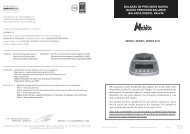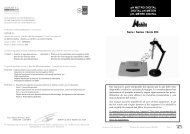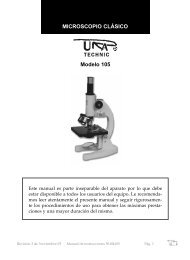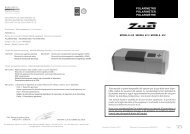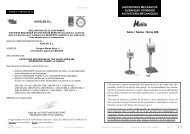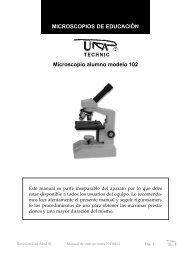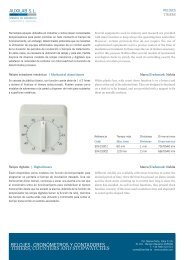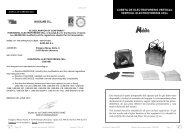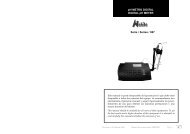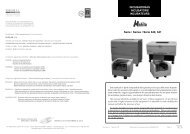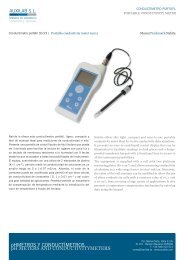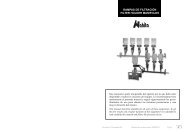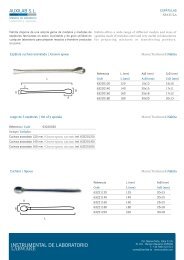MICRÃTOMO DE ROTACIÃN ROTATION MICROTOME ... - Auxilab
MICRÃTOMO DE ROTACIÃN ROTATION MICROTOME ... - Auxilab
MICRÃTOMO DE ROTACIÃN ROTATION MICROTOME ... - Auxilab
Create successful ePaper yourself
Turn your PDF publications into a flip-book with our unique Google optimized e-Paper software.
Porta-cuchillas: mediante un mando de avance<br />
macro se puede regular el grado de aproximación<br />
de la cuchilla al porta-muestras.<br />
Mecanismo de avance: en los microtomos de rotación es el portabloques el que<br />
avanza sobre la cuchilla a la vez que realiza un movimiento arriba-abajo, permaneciendo<br />
la cuchilla inmóvil en todo momento. Para realizar esta serie de movimientos<br />
es necesario un complejo sistema mecánico que permite la realización de<br />
cortes sucesivos de tejidos a partir del bloque.<br />
Cuchilla: desechable universal.<br />
CASTELLANO<br />
Cleaning<br />
ENGLISH<br />
• Never use scourers or substances that can grate for cleaning metallic parts such as stainless<br />
steel, aluminium, coatings, etc. as they damage the microtome and produce an early<br />
ageing of the equipment. Neither use alcohol or alcohol containing detergents nor abrasive<br />
detergents or acetone or xylene containing solvents.<br />
• Use a fluff-free cloth dampened with soaped water that does not contain abrasives.<br />
ATTENTION!! IF EQUIPMENTS ARE NOT PROPERLY CLEAN AND<br />
DISINFECTED THEY WOULD NOT BE ALLOWED TO REPAIR BY OUR<br />
TECHNICAL SERVICE.<br />
7. TROUBLESHOOTING<br />
TROUBLE<br />
CAUSE<br />
SOLUTIÓN<br />
Volante manual: Transmite al mecanismo de<br />
avance el impulso necesario para su funcionamiento;<br />
cada vuelta dada al volante produce una<br />
secuencia de corte. El volante manual presenta<br />
un pequeño mecanismo que lo bloquea en caso<br />
de que el equipo deba ser transportado o cuando<br />
no está siendo utilizado. Por tanto, antes de usar<br />
el microtomo es imprescindible tirar del mecanismo<br />
de bloqueo y dar medio giro al volante<br />
manual para colocarlo en posición de corte.<br />
1. Base porta-cuchillas<br />
2. Palanca sujeción del mecanismo de<br />
desplazamiento lateral<br />
3. Palanca sujeción del porta-cuchillas<br />
4. Porta-cuchillas<br />
5. Palanca sujeción cuchilla<br />
6. Escala ángulo libre<br />
7. Mando selección del espesor de corte<br />
8. Avance macro<br />
9. Palanca bloqueo avance macro<br />
10. Volante manual<br />
11. Bloqueo volante<br />
12. Dispositivo de sujeción del portamuestras<br />
13. Palanca sujeción del porta-muestras<br />
14. Pinza universal para casetes<br />
15. Expulsor de casetes<br />
16. Tornillo de orientación Norte/Sur del<br />
porta-muestras<br />
17. Tornillo de orientación Este/oeste del<br />
porta-muestras<br />
18. Palanca bloqueo orientación<br />
Alternately thick and<br />
thin sections are produced<br />
In extreme cases, no<br />
section is obtained.<br />
Sections are extremely<br />
compressed, wrinkled or<br />
jammed together<br />
Noise during sectioning<br />
Knife "sing." when sectioning<br />
hard samples.<br />
Sections show scratches.<br />
Blade insufficiently clamped<br />
Blunt cutting edge<br />
Knife clearance angle too<br />
narrow.<br />
Blunt cutting edge<br />
Sample too warm<br />
Sectioning speed too high<br />
Sectioning speed too high<br />
Re-clamp blade<br />
Adjust knife holder laterally<br />
or use new blade.<br />
Systematically try wider<br />
clearance angle until optimum<br />
angle width has been<br />
found.<br />
Use different zone of cutting<br />
blade or use new blade.<br />
Cool sample prior to sectioning<br />
Work at lower sectioning<br />
speed<br />
Work at lower sectioning<br />
speed<br />
Pág. 4 Manual de instrucciones 50591000 Revisión 1 Febrero-07<br />
Version 1 February-07 Instruction manual 50591000 Page 4



